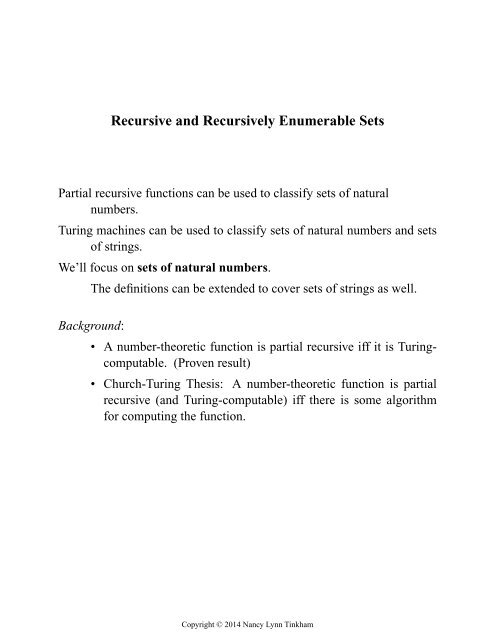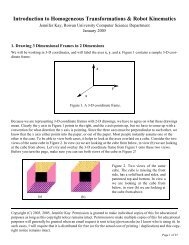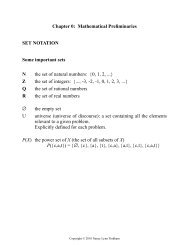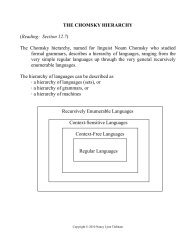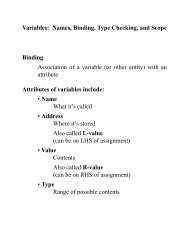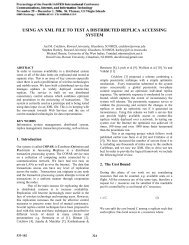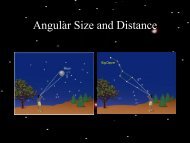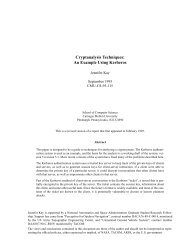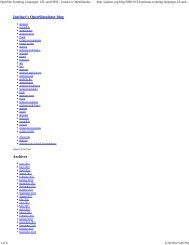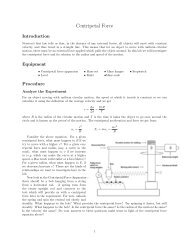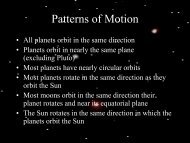Recursive and Recursively Enumerable Sets - Chapter 3 (PDF)
Recursive and Recursively Enumerable Sets - Chapter 3 (PDF)
Recursive and Recursively Enumerable Sets - Chapter 3 (PDF)
Create successful ePaper yourself
Turn your PDF publications into a flip-book with our unique Google optimized e-Paper software.
<strong>Recursive</strong> <strong>and</strong> <strong>Recursive</strong>ly <strong>Enumerable</strong> <strong>Sets</strong>Partial recursive functions can be used to classify sets of naturalnumbers.Turing machines can be used to classify sets of natural numbers <strong>and</strong> setsof strings.We’ll focus on sets of natural numbers.The definitions can be extended to cover sets of strings as well.Background:• A number-theoretic function is partial recursive iff it isTuringcomputable.(Proven result)• Church-Turing Thesis: Anumber-theoretic function is partialrecursive (<strong>and</strong> Turing-computable) iff there is some algorithmfor computing the function.Copyright © 2014 Nancy Lynn Tinkham
Acceptors, Recognizers, <strong>and</strong> GeneratorsAn acceptor for set S answers yes if an element is in the set, <strong>and</strong> has anyother behavior if the element is out of the set.A recognizer for set S answers yes if an element is in the set, <strong>and</strong>answers no if the element is not in the set.A generator for set S outputs the elements of S one at a time, withoutleaving any element out forever. Elements can be printed in anyorder, <strong>and</strong> may be printed more than once.We can use either partial recursive functions or Turing Machines asacceptors, recognizers, <strong>and</strong> generators.Copyright © 2014 Nancy Lynn Tinkham
Important definitions <strong>and</strong> theoremsDefinition: <strong>Recursive</strong>ly enumerable setAset S is recursively enumerable (r.e.) iff either S is the empty setor S = image(f) for some total recursive function f .Examples: <strong>Recursive</strong>ly enumerable sets• The set of even numbers is recursively enumerable, because it isthe image set of f (x) =2*x. The function 2 * x is partial recursive,<strong>and</strong> it is defined for all x; hence, it is total recursive.f(0) = 0f(1) = 2f(2) = 4f(3) = 6(etc.)• The set {1, 2, 3} is recursively enumerable because it is the imageset of f (x) ={xifx=1,2,or3;<strong>and</strong> 1 otherwise}. f is partialrecursive (since defined by cases using constants <strong>and</strong> =), <strong>and</strong> it isdefined for all x; hence, it is total recursive.f(0) = 1f(1) = 1f(2) = 2f(3) = 3f(4) = 1(etc.)Note that {1, 2, 3} is also the image of other functions (e.g., g(x) =(x mod 3) + 1); there can be many enumerations of a set.Copyright © 2014 Nancy Lynn Tinkham
Aset is recursively enumerable if there is a computable (algorithmic,“effective”) way to list all of its members without leaving any out.For any n ∈ S, there is some x such that n = f (x).Repetition is allowed (as in the 2nd example above): n may bef (x) for many different xs.Copyright © 2014 Nancy Lynn Tinkham
Definition: <strong>Recursive</strong> setAset S is recursive iff S has a partial recursive characteristicfunction.Since all characteristic functions are total, this means that S has atotal recursive characteristic function. The central point of thedefinition is that the characteristic function is computable for allinputs.Examples: <strong>Recursive</strong> setsThe set of all numbers less than 3 is a recursive set:χ S (n) = ⎧ ⎨⎩10if n
Theorem: Sisrecursively enumerable iff S=domain(f) for some unarypartial recursive function f .Proof:Note 1: Here, domain(f) means the set of all natural numbers forwhich fisdefined.Note 2: “S = image(g)” makes g a kind of generator for S.“S = domain(f)” makes f a kind of acceptor for S.Note 3: We don’t have non-total characteristic functions. ftakesthe place of a characteristic function for r.e. sets: instead of lookingfor 1/0, we look for defined/undefined.Case 1: SisemptyThe theorem is an “iff” assertion, so the proof is in 2 parts.a) ∅ is recursively enumerable:∅ is explicitly stated in definition of “recursively enumerable”b) ∅ is the domain of a unary partial recursive function f:If f is the everywhere-undefined function, then ∅ is the domain of f.Mn[C 2 1]isone definition of f.That is, f(n) = µm[C 2 1(n, m) = 0 <strong>and</strong> C 2 1(x, m) is defined for all x < n].Copyright © 2014 Nancy Lynn Tinkham
Case 2: SisnonemptyThe theorem is an “iff” assertion, so the proof is in 2 parts.a) If S=image(g) for some total recursive function g, then S =domain(f) for some unary partial recursive function f.Idea:We have g → S We have a generatorWe want S → fWe want to build an acceptorAssume that there exists a total recursive function g such that S =image(g).Define f thus:f (n) = ⎧ ⎨⎩1if ∃i such that g(i) = nundefined otherwiseCompute f (n) bycalculating g(0), g(1), etc., until i is found.If there is an i, eventually the procedure will halt, <strong>and</strong> f returns 1.If there is no such i, the procedure will never halt, <strong>and</strong> f isundefined.Copyright © 2014 Nancy Lynn Tinkham
) If S=domain(f) for some unary partial recursive function f, thenS=image(g) for some total recursive function g.Idea:We have S → f We have an acceptorWe want g → SWe want to build a generatorSince f is a partial recursive function, it can be computed by someTuring Machine M.We will construct a TM M 1 that writes elements of S on a tape.From this, we construct a TM M 2 that computes a function g suchthat S = image(g).First draft: M 1 follows this algorithm:Compute f(0) by simulating M.If M halts with a number as output, write 0 on the outputtape.If M does not halt (or halts with a non-number), write nothing<strong>and</strong> proceed to the next step.Repeat for f(1), f(2), f(3), etc.Each time that M halts with a number as output when computingf(i), write i on the output tape.Define g(n) tobethe n th number written on the tape in this fashion.M 2 computes g(n) bysimulating M 1 until n numbers havebeen written on the tape, then reporting that n th number.This algorithm has a serious flaw. What is it?Copyright © 2014 Nancy Lynn Tinkham
Problem: If f (x) isundefined for some x, M won’t halt for that x, <strong>and</strong>M 1 will get stuck.Copyright © 2014 Nancy Lynn Tinkham
Second draft: M 1 follows this algorithm, which uses dovetailing:Simulate M on input 0 for 1 step.Simulate M on inputs 0 <strong>and</strong> 1 for 2 steps.Simulate M on inputs 0, 1, <strong>and</strong> 2 for 3 steps.Etc.Any time that M halts with input n, write n on the outputtape.As before, define g(n) tobethe n th number written on the tape in thisfashion. M 2 computes g(n) bysimulating M 1 until n numbers havebeen written on the tape, then reporting that n th number.Copyright © 2014 Nancy Lynn Tinkham
Definition: Turing Machine as set generator, version 1 (Sudkamp):ATuring machine generates a set of numbers S by writing asequence of numbers on its tape, separated by a delimiter such as#.The TM is required to write all <strong>and</strong> only members of S. Anumbermay be written on the tape more than once.If S is infinite, then of course there will be no time at which theTM is done writing; however, for any n ∈ S, there will be a time atwhich n has been written on the tape.Definition: Turing Machine as set generator, version 2 (Taylor):Alternatively, aTuring Machine generator for a set S takes anumber n as input <strong>and</strong> produces as output the n th item in anenumeration of S.Sudkamp is Thomas Sudkamp, Languages <strong>and</strong> Machines, Addison-Wesley, 1996.Copyright © 2014 Nancy Lynn Tinkham
Check that a Sudkamp-type generator <strong>and</strong> a Taylor-type generatorare equivalent:Sudkamp: Write elements of set S on a tapeTaylor: Given input n, write the n th element of an enumeration ofSonanoutput tape.How would you build a Taylor-type generator from a Sudkamp-typegenerator?How would you build a Sudkamp-type generator from a Taylor-typegenerator?Copyright © 2014 Nancy Lynn Tinkham
First Turing-machine formulation of recursively enumerable sets:Aset S is recursively enumerable iff itcan be generated by aTuring machine.Why isthis equivalent to the earlier definition — S is the image of atotal recursive function g?A generator (in Taylor’s sense) computes a function g whoseimage set is S.Copyright © 2014 Nancy Lynn Tinkham
Turing-machine formulation of recursive sets:Set S is recursive iff S is recognized by a Turing machine.Why isthis an equivalent definition?Aset S is recursive iff S has a (total) recursive characteristicfunction.The Turing Machine to recognize S is exactly the Turing Machinethat computes S’s characteristic function.Copyright © 2014 Nancy Lynn Tinkham
Theorem:Every recursive set is recursively enumerable.Think: Why isthis true?Think about recognizers <strong>and</strong> acceptors.This one is easy.Copyright © 2014 Nancy Lynn Tinkham
Theorem:Every recursive set is recursively enumerable.Proof:If S is recognized by a TM M, then it is accepted by M.Copyright © 2014 Nancy Lynn Tinkham
Theorem:Aset S is recursive iff both S <strong>and</strong> S C are recursively enumerable.Think: Why isthis true?If you have an acceptor for S<strong>and</strong> an acceptor S C ,how would you make arecognizer for S?Copyright © 2014 Nancy Lynn Tinkham
Theorem:Aset S is recursive iff both S <strong>and</strong> S C are recursively enumerable.Buggy Proof:If S <strong>and</strong> S C are both r.e., then there are TMs M 1 which accepts S <strong>and</strong>M 2 that accepts S C .Build a third TM M:M simulates M 1 on input n, then simulates M 2 on input n.If M 1 accepts n, then accept n.Else if M 2 accepts n, then reject n.One of the two machines has to accept n, sowe’re guaranteed toget an answer.Why isthis buggy?Copyright © 2014 Nancy Lynn Tinkham
Theorem:Proof:Aset S is recursive iff both S <strong>and</strong> S C are recursively enumerable.If S <strong>and</strong> S C are both r.e., then there are TMs M 1 which accepts S <strong>and</strong>M 2 that accepts S C .Build a third TM M: Given input n, M simulates M 1 on one work tape<strong>and</strong> "simultaneously" simulates M 2 on a second work tape.In more detail, M simulates M 1 for one step, then M 2 for one step,then M 1 for one more step, then M 2 for one more step, etc.Eventually, either M 1 will halt or M 2 will halt.(Why? — nisineither S or S C . The TM for whichever set nisinis required to halt <strong>and</strong> answer 1 eventually. Wemight additionallyget lucky <strong>and</strong> get a "no" answer from the other machine, thoughwe can’t count on that.)When one machine halts, we halt <strong>and</strong> report 1 or 0, as appropriate.Copyright © 2014 Nancy Lynn Tinkham
Theorem:Any finite set S of natural numbers is recursively enumerable.Think: Why isthis true?List the elements of set S in some order: n 0 , n 1 ,... , n k .Can you write an algorithm to accept S?Can you write an algorithm to generate S?Copyright © 2014 Nancy Lynn Tinkham
Theorem:Any finite set S of natural numbers is recursively enumerable.Proof (algorithm to accept S):Let S ={n 0 , n 1 ,... n k }.To check whether a number x is in S, check:Is x = n 0 ?Is x = n 1 ?...Is x = n k ?Stop if one of the checks is true, <strong>and</strong> answer "yes".Proof (algorithm to generate S):Print n 0Print n 1...Print n k(Note that this executes in finite time.)Proof (using partial recursive functions):List the elements of set S in some order: n 0 , n 1 ,... , n k .Define f (n) =⎧⎪⎨⎪⎩n 0 if n = 0n 1 if n = 1...n k if n ≥ kf is partial recursive, since it is defined by cases usingconstants, =, <strong>and</strong> ≥.f is total.S=image(f); thus S is recursively enumerable.
Theorem:Any finite set S of natural numbers is recursive.Proof (algorithm to recognize S):Let S ={n 0 , n 1 ,... n k }.To check whether a number x is in S, check:Is x = n 0 ?Is x = n 1 ?...Is x = n k ?Stop if one of the checks is true, <strong>and</strong> answer "yes".If the loop reaches the end <strong>and</strong> none of the checks is true, answer "no".Proof (using characteristic functions):List the elements of set S in some order: n 0 , n 1 ,... , n k .χ S =(n=n 0 ∨ n=n 1 ∨ ... ∨ n=n k ).This function is partial recursive (<strong>and</strong> total).Copyright © 2014 Nancy Lynn Tinkham
Summary: <strong>Recursive</strong> <strong>and</strong> <strong>Recursive</strong>ly <strong>Enumerable</strong> <strong>Sets</strong>Definition: <strong>Recursive</strong>ly enumerable setAset S is recursively enumerable (r.e.) iff either S is the empty setor S = image(f) for some total recursive function f .Function f is a generator for S.Definition: <strong>Recursive</strong> setAset S is recursive iff S has a partial recursive characteristicfunction.That is, the characteristic function is computable for all inputs.Theorem: Sisrecursively enumerable iff S=domain(f) for some unarypartial recursive function f .Function f acts like anacceptor for S.Copyright © 2014 Nancy Lynn Tinkham
Definition: Turing Machine as set generator, version 1 (Sudkamp):ATuring machine generates a set S by writing a sequence ofnumbers on its tape, separated by a delimiter such as #.The TM is required to write all <strong>and</strong> only members of S. Anumbermay be written on the tape more than once.If S is infinite, then of course there will be no time at which theTM is done writing; however, for any n ∈ S, there will be a time atwhich n has been written on the tape.Definition: Turing Machine as set generator, version 2 (Taylor):Alternatively, aTuring Machine generator for a set S takes anumber n as input <strong>and</strong> produces as output the n th item in anenumeration of S.First Turing-machine formulation of recursively enumerable sets:Aset is recursively enumerable iff itcan be generated by a Turingmachine.Second Turing-Machine formulation of recursively enumerable sets:Set S is recursively enumerable iff Sisaccepted by some Turingmachine.That is, S has a generator exactly if S has an acceptor.Turing-machine formulation of recursive sets:Set S is recursive iff S is recognized by a Turing machine.The Turing Machine computes the characteristic function of S.Copyright © 2014 Nancy Lynn Tinkham
Theorem:Every recursive set is recursively enumerable.Theorem:Aset S is recursive iff both S <strong>and</strong> S C are recursively enumerable.Theorem:Any finite set of natural numbers is recursively enumerable.Theorem:Any finite set of natural numbers is recursive.Copyright © 2014 Nancy Lynn Tinkham
Intuition of recursive <strong>and</strong> r.e. setsGeneratorAccept/Recognize<strong>Recursive</strong> Generate algorithmically Recognizein increasing order algorithmically<strong>Recursive</strong>ly Generate algorithmically Acceptenumerable (perhaps w/ repetitions, algorithmicallyin no particular order)Properties of complementsIf S <strong>and</strong> S C are both R.E., then S is recursive.<strong>Recursive</strong>: If S is recursive, then S C is recursive.R.E.: If S is R.E. but not recursive, then S C is not R.E.Copyright © 2014 Nancy Lynn Tinkham


